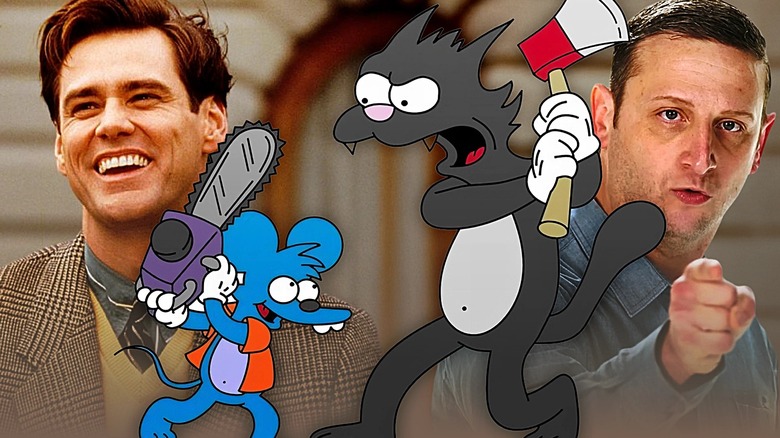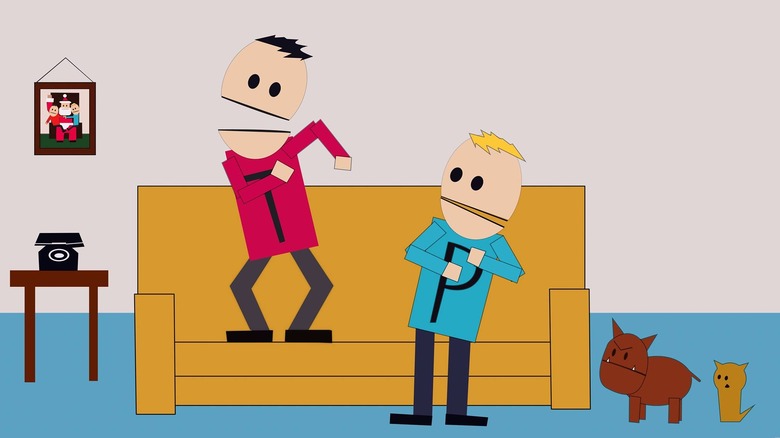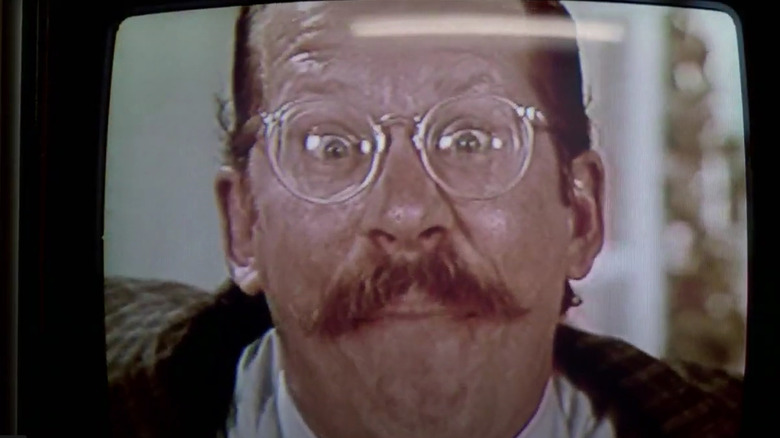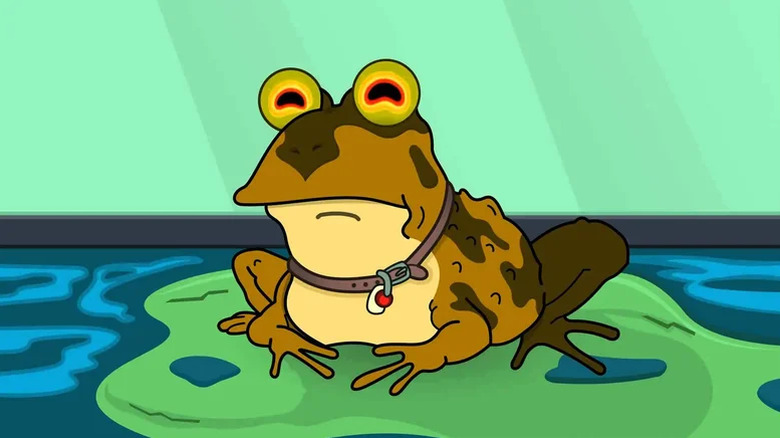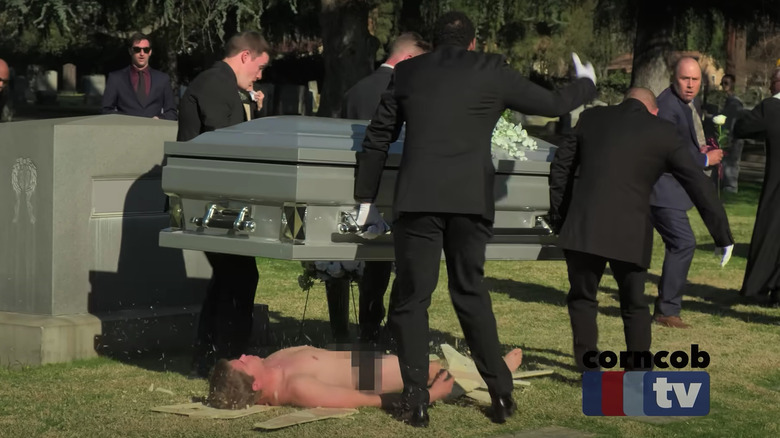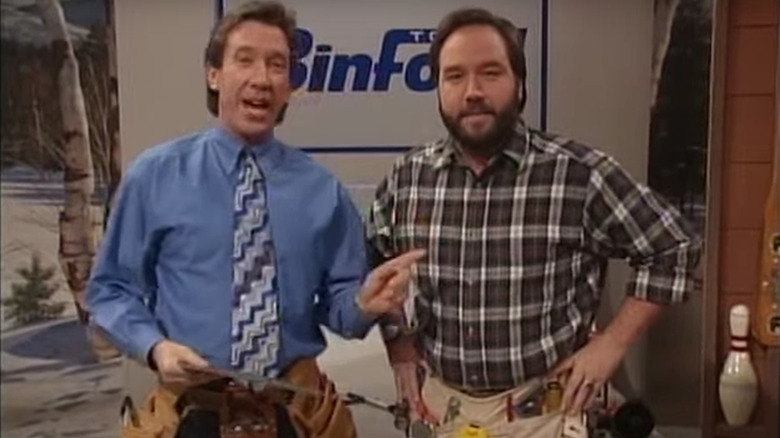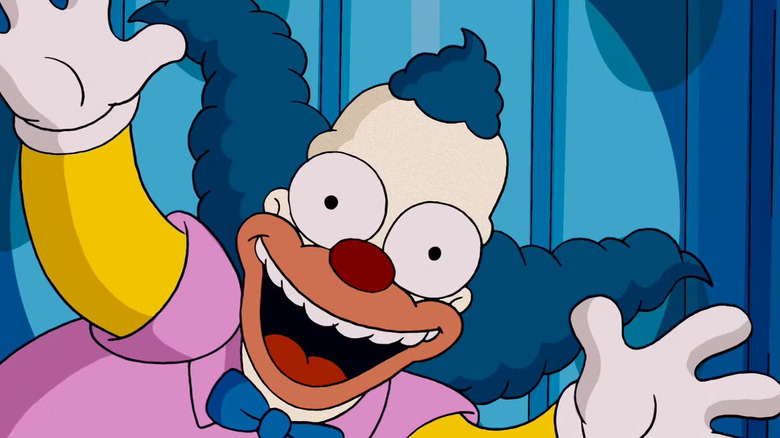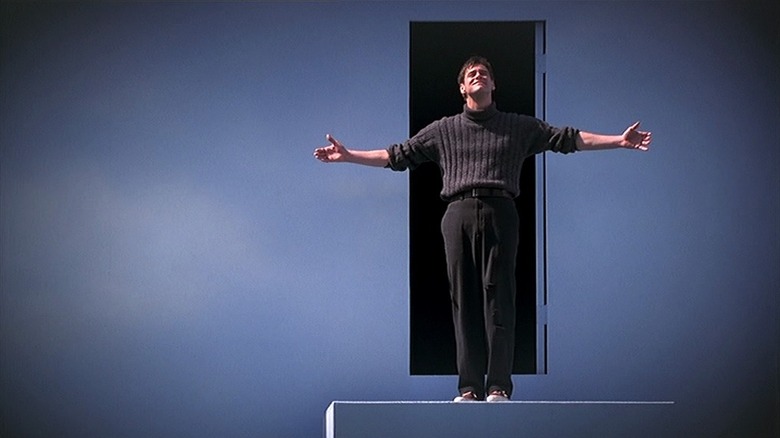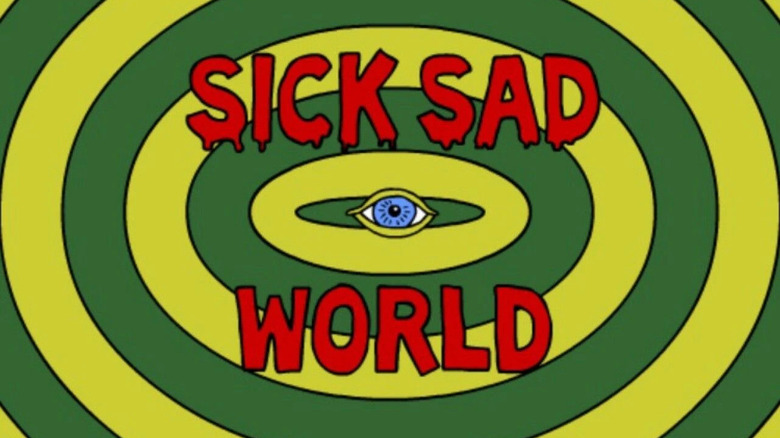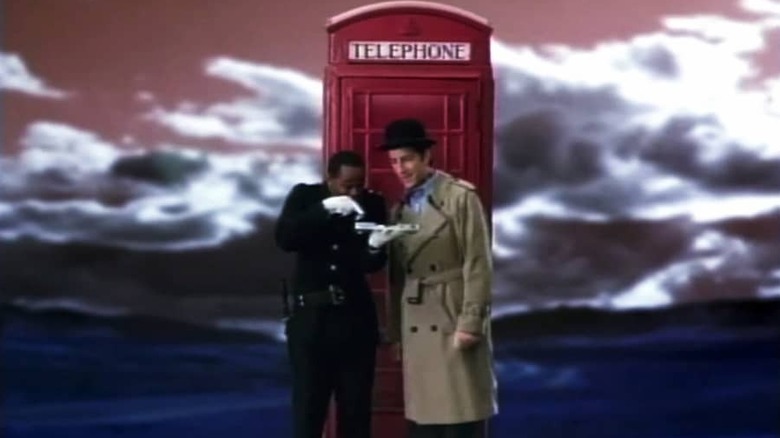10 Best Fake TV Shows From Other Movies And TV Shows
We don't normally watch TV to watch other people watching TV, but when the satire is sharp or the allegory strong, the fictional shows within some of our favorite shows and movies can be funnier, more extreme, or even more transformative than any that would possibly exist or be greenlit in reality. Beavis and Butt-Head's reactions to generic TV shows and music videos comment both on what the messages are in the medium and how they're received by the target audience, and the holographic entertainment watched by Wookiees in "The Star Wars Holiday Special" tell us that TV under the rule of the Empire is insanely terrible.
Sometimes we're quite envious of what the fictional characters get to see. Even if some of the shows in their universe might seem odd to us, they look like they would work well in the contexts of their own reality. A program that might seem objectively bad in our world, for example, could exist in a realm where it has powers and relatability we just can't approach for real. We've tried to avoid shows that actually are bad as presented — "The Larry Sanders Show" we watch, for example, is a great show about a really cringey show of the same name. All of the shows on this list, meanwhile, are at least appreciated by the audience they aim for.
These are the 10 best fake TV shows from other TV shows and movies.
The Terrance and Phillip Show (South Park)
In response to criticisms that "South Park" (leaving HBO Max in 2025) was just poorly animated characters making fart jokes, creators Trey Parker and Matt Stone made a show within the show that was literally just that. Terrance, a.k.a. Sir Terrance Henry Stoot, and Phillip, a.k.a. Sir Phillip Niles Argyle, are two Canadian characters who simply spend their entire show farting on each other and laughing loudly about it. Initially supposed to be animated characters (Cartman in "South Park: Bigger, Longer & Uncut" claims, "The animation's all crappy!"), their overly simplified designs later evolved into the default appearance of all Canadian characters on "South Park."
The show is beloved by the children in the town of South Park because of its simplicity, but over time, the characters have added more than fart jokes to their repertoire. Their movie "Asses of Fire" added ridiculously excessive amounts of profanity,and musical numbers, while the episode "Not Without My Anus" sent them on a full half-hour adventure. Behind the scenes of their TV series, the characters have suffered from marital problems, weight issues, diabetes, and becoming the cause of a war between Canada and the United States, which brought about a near-apocalypse at the hands of Satan and Saddam Hussein in the "South Park" movie. They've also spawned or helped other equally gloriously moronic shows we would totally watch, like "The Q***f Sisters" and "Russell Crowe's Fightin' Round the World."
It's Not My Problem (RoboCop)
The TV universe of "RoboCop" (a film that almost didn't happen) is more fleshed out than that of most movies, featuring news programs with overly styled hosts and the quick-shot action heroics of cop show "T.J. Lazer." Easily the most popular, though, judging by the number of characters who watch and quote it, even through store windows, is "It's Not My Problem," with its omnipresent catchphrase, "I'd buy that for a dollar!"
It's hard to tell exactly what kind of show it is, but all visual evidence suggests that star Bixby Snyder is a Benny Hill-style comedian who finds himself in risqué situations. In the video game "Rogue City," a magazine headline announces his arrest. In a scene deleted from the first film's script, his crime is revealed to be soliciting sex from underage costars. By the time of "RoboCop 3," however, he's back on the air, because of course there's no cancel culture in dystopian futures. Perhaps the biggest question, however, is in that corporately owned world, what exactly can a fellow buy for a mere dollar? Maybe that's the real joke.
Actor S.D. Nemeth only had the one catchphrase line to deliver, but he took the time to think about the character, basing him on the Young Marquis character he once played on a KROQ radio show.
Everybody Loves Hypnotoad (Futurama)
Boiling down TV to its absolute barest essentials, the creature known as Hypnotoad simply sits still in front of a camera and hypnotizes the audience for what we presume is a half-hour timeslot. The show is renewed for three seasons. In addition to hypnotized viewers, the show also appeals to not-very-smart humans like Philip Fry, who find the Hypnotoad's color-changing eyes and horrible yet hilarious mechanical droning sound to be sufficient entertainment. Although by the third season, even Fry felt the newer episodes weren't as good.
While Hypnotoad is obviously an on-the-nose parody of the idea that watching too much TV turns people into zombies, we have to wonder what the experience is like for viewers in the "Futurama" world. Does it feel like you're a stoned guy staring into a blacklight poster? Is it like a "Magic Eye" illusion that produces a hidden 3D image once you alter your depth perception with a squint? We will probably never know, but there's something compelling about the image nonetheless.
Coffin Flop (I Think You Should Leave)
Not unlike "Ow! My Balls!", the most popular TV show of the future in "Idiocracy," "Coffin Flop," as seen on Netflix's sketch show "I Think You Should Leave with Tim Robinson," has a simple premise: real-life footage of dead bodies falling out of coffins, with at least 20 percent guaranteed to be naked. Considering the way it's promoted as the premiere program on cable network Corncob TV, however, it feels like there's potential there for more than just repetitive slapstick. Why does the showrunner/network executive (Robinson) seem like a psychopath about to crack? If the show isn't rigged, as he claims, who's letting these people film funerals? Are they in league with purveyors of cheap wood? How do the unwitting participants sign off on this footage making it to air?
"Coffin Flop" itself might be compelling in its stupidity and creepiness, but viewers would most likely keep watching just to see what happens when the creator — or any of the poor families of the corpses he films — absolutely loses it.
If you enjoy the comedic premise, check out 16 more hilarious sketches from "I Think You Should Leave."
Tool Time (Home Improvement)
The end credits of "Home Improvement" always stated, "Based on the stand-up comedy of Tim Allen," but really, it was "Tool Time," the show within the show, that was most based on Allen's "Men Are Pigs" routine. After all, it's not like he regularly did bits at the comedy clubs about helping his kids through tough times at school or misunderstanding life lessons from an intellectual neighbor hidden behind the fence. No, Allen's main comedy fame came from him grunting like a hog onstage while extolling the virtue of power tools.
Ostensibly a legitimate home improvement show sponsored by the fictional Binford Tools, "Tool Time" nearly always featured Allen's Tim "The Toolman" Taylor character screwing things up and/or injuring himself with said power tools, while sidekick Al (Richard Karn) would inevitably do the task correctly. It's unclear quite why Binford would keep such an accident-prone host, as their insurance premiums must have been through the roof. However, some episodes suggested that the viewers, and perhaps executives, thought Tim was deliberately hurting himself to show the audience at home what not to do. Basically, they were effectively doing "Jackass" before MTV, even if that wasn't quite Tim's intent.
As a bonus, "Tool Time" also featured a pre-"Baywatch" Pamela Anderson as Lisa, the original "Tool Time Girl." It strikes us that there just might be a deliberate double entendre in there somewhere. Former President Jimmy Carter, meanwhile, was canonically a fan of Al.
The Krusty the Clown Show (The Simpsons)
"The Simpsons" has been on the air well over three decades now, but "The Krusty the Clown Show" was intentionally outdated from the getgo. Bozo the Clown, the most obvious antecedent, may have lasted into the early 2000s, but his show hit peak popularity by the early '80s, as rising costs of live-action production and rules against certain types of sponsorship made that type of variety program less profitable than cartoons.
No such rules applied to Krusty in the universe of "The Simpsons," as he continued to shamelessly peddle cheap products, poorly acted sketches, and outdated shtick, all while coasting on the success of the ultra-violent "Itchy and Scratchy Show," a parody of a knock-off of Tom and Jerry, that took on a life of its own. Their mindless violence never got old, but Krusty was practically born aged and irrelevant, though his fast food chain continues to prevail.
Because "The Simpsons" characters stay the same age, the timeframe — and related flashbacks — keeps shifting. In the real world, Krusty would probably have gone from having a "so bad it's good" ironic fandom in the '90s to a more sincer "We appreciate his commitment to the bit" fandom today, much as Tommy Wiseau has managed with "The Room." Alternately, perhaps, Krusty would have been well and truly canceled by now for his routinely terrible behavior. Nonetheless, if we lived in Springfield, we'd totally (if mildly disapprovingly) watch the smoking monkey.
The Truman Show (The Truman Show)
The first baby to be legally adopted by a TV network grows up unaware that he's living in the world's largest, most controllable soundstage, with his life viewed by millions, and his supporting cast presumably securing lucrative, multiple-year contracts to keep up the pretense. Such is the premise of "The Truman Show," the series within the movie also titled "The Truman Show," which some believe is Jim Carrey's best movie.
During the course of the latter, however, Truman (Carrey) finally reaches an age and level of intelligence to realize something's off about the whole thing, and he plans to escape. Though show creator Christof (Ed Harris) tries to stop him, he fails to realize that the chase is actually making the TV show more compelling viewing than ever. The only problem is that if Truman wins, the show ends.
Since "The Truman Show" and the similarly themed "The Matrix," the notion that we're all living in a simulation has become more of a conversation topic among philosophers, scientists, and late-night dorm rooms, along with at least one documentary called "A Glitch in the Matrix." Reality TV, meanwhile, has been exposed as more staged than ever, and in real life, Truman would probably be aware of everything and playing dumb to the cameras.
If this is a simulation, and we ever find our way out, may we all be as gracious as Truman about it.
Sick Sad World (Daria)
Are bats sneaking into your neighborhood disguised as cute flying squirrels? Can anger management training really help gorillas avoid extinction? Would you moan my name if I boinked you in Heaven? These questions, and more, are answered, in a manner of speaking, by the show "Sick Sad World," the favored show of prototypical '90s cynical teens Daria Morgendorffer and Jane Lane. Too smart to be popular, they appreciate TV that's as cynical as they are, and a show more prone to conspiracy theories that seem to yearn for anything more interesting than mundane reality.
This was the era of "The X-Files," when such theories and mythologies were more likely to be about aliens than your political opponents. Like the Weekly World News tabloid in the '80s, "Sick Sad World" probably fooled its most gullible consumers, while being enjoyed and hate-watched by those who felt superior, or liked weird for the sake of weird.
Considering Daria itself spun off of a show about massively cranially deformed metal-heads (see "Beavis and Butt-Head") doing stupid things and lighting fires, "Sick Sad World" may, on a meta level, be paying subtle tribute to the lead character's origins. The two ever-tittering boys would likely be among the gullible and think everything depicted on the show was pretty cool. Just don't tell Daria her low-IQ frenemies might momentarily share her taste.
Inspector Spacetime (Community)
Dan Harmon loves creating fake TV shows-within-shows so much that entire episodes of "Rick and Morty" are dedicated to just alien TV channel-surfing. But it's in live-action that his best fake creation came to be: the "Doctor Who" parody "Inspector Spacetime" on "Community."
A program that has never stopped running since 1962 (which is pointedly one year earlier than "Who"), it initially looks like a pretty simple riff, with its lead character dressed more like Inspector Clouseau than the Doctor, and the time-and-space vehicle styled after a red phone booth rather than a blue police box. Harmon didn't stop there, though, ultimately creating an elaborate backstory that involves a poorly received "Star Wars"-ish holiday special (unlike the popular "Doctor Who" Christmas episodes) which ostensibly cost the show's creator his knighthood. Then there was an American spinoff starring Luke Perry and Jennie Garth — at least when "Doctor Who" went in that direction, we got Paul McGann.
The best thing about "Inspector Spacetime," however, is that it has the power to overcome the heartbreak of a prior TV favorite ending badly. When Abed (Danny Pudi) becomes practically comatose in despair over the finale of "Cougarton Abbey," in which all the characters commit suicide by poison (because that's just how British shows are sometimes), it takes an "Inspector Spacetime" episode to draw him out of his funk.
The fake series even spawned a real-world bootleg online sequel, "Untitled Web Series About a Space Traveler Who Can Also Travel Through Time."
The Pink Opaque (I Saw the TV Glow)
Named after a 1986 Cocteau Twins compilation album, 'The Pink Opaque" plays like a combination of "Buffy the Vampire Slayer," Mighty Morphin' Power Rangers" and "Are You Afraid of the Dark?" and in the world of "I Saw the TV Glow," it's the only outlet for teenagers Owen (Justice Smith) and Maddy (Jack Haven), who feel like they're repressing their true selves in their dead-end town, only truly feeling connected to a larger reality through the show. The series itself features two teenage girls who fight a supernatural, moon-shaped villain named Mr. Melancholy and his monsters of the week, one of which looks like a giant, anthropomorphized ice cream cone.
Maddy runs away from home, and reappears years later claiming that she and Owen really are the lead characters in the show, with their supposed "real" lives being the truly fake ones. It isn't clear to Owen what's going on, and he's too afraid to find out. Many years later, he rewatches the show and finds it to be much cheesier and fake-looking than he remembered.
The show as metaphor is intended to mirror the transgender experience of realizing one's birth body doesn't align with inner gender identity. Taken purely on the surface level as a show, though, it's so immersive that it makes a viewer question their own reality and perhaps even learn their true selves — if they're brave enough to take that leap. That's one heck of a program. Who wouldn't be curious to watch?
